REJUVENATION THROUGH TRANSPLANT OF THE CEREBRAL HEMISPHERES
Despite the fact that contemporary
experimental neurosurgery has not been able to design an infallible technique
that can be used in transplanting the brain of human beings, moral questions
still exist that must be addressed if this type of surgery is to be
contemplated. It is feared that egotism to preserve life or power might lead
some men to attempt to perpetuate themselves by means of this transplant of
their brain into a young body. This is why contemporary scientists indicate the
limits of the use of this transplant: they affirm that it would only be
justified in saving lives. It is understood that the brain would be transplanted
in the body of a man who maintained normal bodily functions but whose brain had
deteriorated to a level where it could not be recuperated. It is also understood
that the brain to be transplanted would be in perfect conditions and would come
from a person whose body suffered from mortal illness or accident. According to
the information contained in many gliptoliths I can confirm that the transplant
of the cerebral hemispheres was one of the recourses to which the gliptolithic
humanity turned to reach the goals of its existence: to develop its reflexive
capacity (cognitive energy) to increase and conserve knowledge. The object was
to conserve in the body of a young individual the formidable amount of knowledge
contained in the brain of an elderly person. By extracting the cerebral
hemispheres of a young man, all those other parts of the brain that control the
organic and glandular functioning remained. The cerebral hemispheres that
contained this enormous amount of knowledge, on being transplanted, continued
functioning, but now commanded by the functions of the young manís body. I
deduce that in this way the cells of the two hemispheres were rejuvenated and
thus the organism was able to recuperate its cellular harmony.
It would not be surprising that
those men that enjoyed extraordinary longevity of whom the traditions that come
out of a distant past speak were simply the result of this technique employed by
the gliptolithic humanity. This would explain the cases in which, according to
legend, the same man appeared before other people with different physical
appearance. And the references in legends to men that were able to change
themselves into monsters, beasts, tree, mountains and different objects would be
nothing but an exaggeration of this change in physical appearance, made up by
generations whose imagination was stimulated by the distant past when the
gliptolithic humanity existed. It is to be supposed that the use of a series of
young bodies to conserve the knowledge locked into the cerebral hemispheres
continued in a chain that was only broken by the fortuitous death of the
individual whose brain was transplanted. As concerns the use to which the
extracted cerebral hemispheres of the young subject whose body is used, the
gliptoliths do not offer very clear information. Based on information from
another series of gliptoliths that represent the transplant not of cerebral
hemispheres but rather of the knowledge itself (cognitive keys), it seems
possible that the cognitive keys of the hemispheres of this young man could have
been transplanted into an individual of lower cognitive ranking. As concerns the
fate of the body of the old individual I only know what is observed in one of
the gliptoliths that I have just described: it is maintained alive artificially.
In contemporary culture, the transplant
of the body would cause certain problems of a familiar and social nature. A man
with a brain transplant would be the same man only from a physical point of
view. From this point of view, his family and his social group would expect him
to think and act as he did before. But in truth he would be thinking and acting
according to the new brain, that is with the other personality, that is now the
only one he has. This would create a rupture in his life relationships. In the
gliptolithic humanity, after a transplant of the cerebral hemispheres, there
occurred no such rupture, simply because the family as it is now known did not
exist, and social levels were determined by cognitive rank. The men of the
gliptolithic humanity were oriented towards intellectual activity. Man achieved
his highest goals through the insatiable desire to develop his capacity for
reflection (cognitive energy) to increase his knowledge. This desire permitted
him to permanently achieve spiritual well being. In his relations with the
opposite sex, the sexual appetite was the result of the need to procreate, and
the son was integrated as a member into society. This was the family. Aside from
her sex, a woman was seen no differently from a man. She had the same rights and
liberties and, as a member of the gliptolithic society, her existence was
oriented towards the same goals as that of the man. That the difference in sex
did not imply differences in liberties and rights I deduce from the fact that in
the figures of the men as well as the women the sexual organs are not drawn in.
HEART TRANSPLANT
The first heart transplant in
contemporary society was performed by the famous heart surgeon Christian Barnard
in 1967. Since then this type of heart transplant has been performed in many
medical centers all over the world. But the problem continues to be the
rejection of the transplanted heart. Aside from the recent case of the
transplant of a complete heart next to another heart, performed also by
Christian Barnard, the so called heart transplants that are performed are not of
the whole organ. Only the ventricles and the front face of the auricles are
transplanted, so that the receiver of the transplant still retains part of his
own heart and the main blood vessels and arteries that correspond to it. The
problem of the rejection of the heart has never permitted the individual to live
more than two years.
Gliptolithic surgery performed
transplants of the entire heart solving the problem of rejection, as has been
mentioned, by using blood transfusions from a pregnant woman to the individual
who was to receive the organ and at the same tine irrigating the heart to be
transplanted with the blood of the same woman. It is noteworthy that in all the
organ transplants represented in the gliptoliths there is not one reference to
the methods employed to unite severed blood vessels. It is well known that a
fundamental part of contemporary surgical technique for the transplanting of
organs is the skill with which blood vessels are united. It is possible that
gliptolithic surgery united the vessels by means of reabsorbable tubes, one of
the methods used by contemporary surgery. That is to say: each extreme of the
tube is inserted in the orifices of the severed vessel; thus the tube acted as
an internal bridge that allowed the two extremes of the vessel to be united.
After a certain amount of time, undoubtedly specified, the vessel would be
united through the regeneration of the cells, and the tube would be diluted into
the blood stream. It is also noteworthy that the complicated system of
electrical apparati was not limited to controlling the biological functions of
the patient - as in contemporary surgery - but rather that it stimulated and
maintained these functions exactly as they might have been stimulated and
maintained by the centers that command these functions in the human organism.
Part of what I write in this chapter
about gliptolithic surgery I had the chance to talk about in the IV Congress of
the
Western
Hemisphere, organized by the International College of Surgeons, that took place
in Panama. I had the honor of giving a paper at this Congress by invitation of
the then President of the International College of Surgeons, Dr. Esteban D. Roca,
eminent Peruvian neurosurgeon, of whom I had the honor of being a student at the
Universidad Nacional Mayor de San Marcos and of being a colleague of his in his
medical practice in the Peruvian Seguro Social (Social Security Service).
The scenes that inform us about
different phases of the transplant of the heart appear in a series of ten
gliptoliths, dark in color, the majority of which are approximately one meter in
diameter. The figures and symbols are engraved using the deep scoring technique
and a certain relief in the background to give emphasis to the figures (See
Figs. 48, 49, 50, 51, 52, 53, 54, 55, 56 and 57).
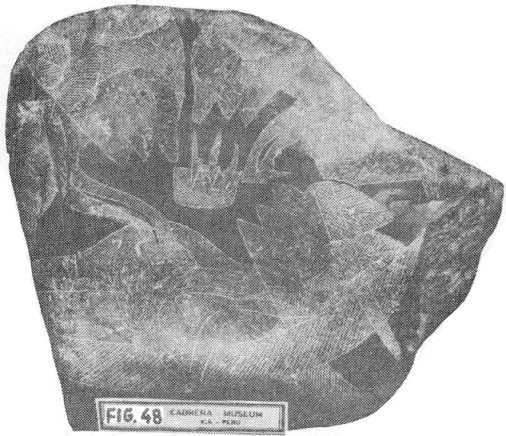
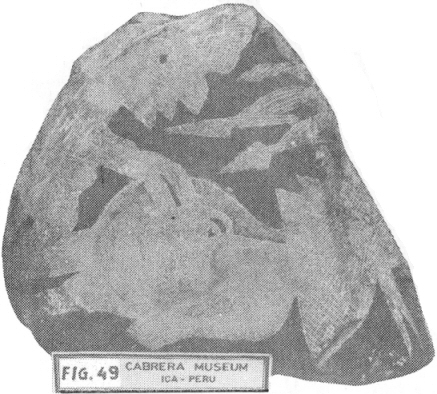
FIGURE 48: The donor of the heart
to be transplanted is found alive on the operating table with an incision in the
abdomen through which the surgeon has inserted his hands and is touching the
patient's heart. The complex system of electronic apparati suggested
symbolically by the triangular segment full of rhomb-shaped figures under the
patient's neck is controlling the biological functions. The assistant surgeon
bears a receptacle holding the medical instruments, symbolically drawn.
FIGURE 49: The donor of the heart is dead. This is symbolically expressed
through the absence of the operating table and the system of complex electronic
apparati that controlled his biological functions.
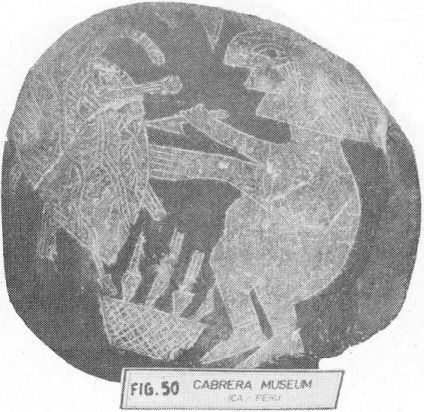
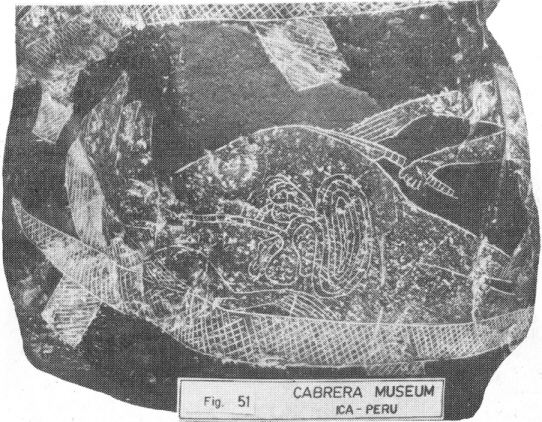
FIGURE 50: The heart that is to be transplanted is being prepared
for irrigation with the blood of a pregnant woman. Notice that the large vessels
have been severed. The vessels that irrigate the heart, drawn on purpose over
its surface, will be connected to the irrigating mechanism (the connection can
be seen in Fig. 40).
FIGURE 51: The individual who is to receive the transplant of the heart lies on
the operating table. The surgeon readies himself to make an incision in the
abdomen to extract the heart that is to be replaced. The triangular segment full
of rhomb-shaped figures under the neck of patient indicates that his biological
functions are being stimulated and controlled, so that he will not die.
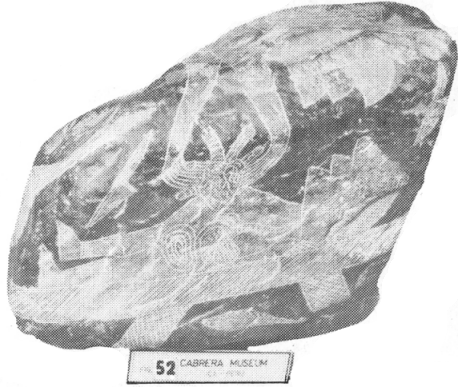
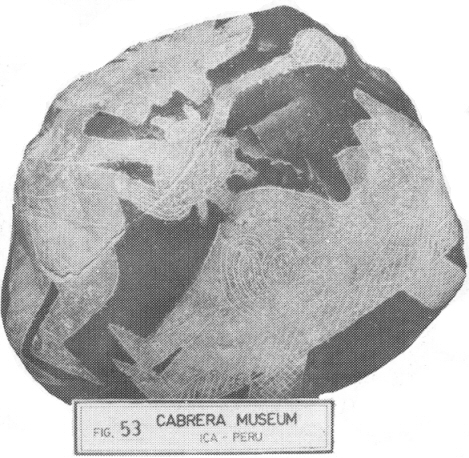
FIGURE 52: The instant at which
the individual two is to receive the heart transplant is having his heart
removed. Notice that despite the fact that he has been left without a heart, he
continues to be subject to the stimulus and control of his biological functions,
judging by the triangle full of rhomb-shaped figures under his neck. This is
explainable if it is understood that the complex system of electronic apparati
that stimulates and controls the biological functions of the individual is also
in charge of maintaining the circulation of the blood. The individual is thus
alive, as can be confirmed by the leaf - a symbol of life - that can be seen
under the operating table.
FIGURE 53: The heart of the donor is being irrigated with the blood of a
pregnant woman and is at the point of being transplanted. Despite the fact that
the receptor of the transplant does not have a heart his biological functions
are maintained through the action of the complex system of electronic apparati,
judging by the triangle full of rhomb-like figures that appear under his neck.
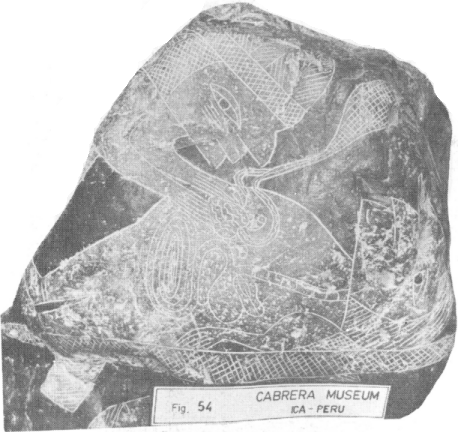
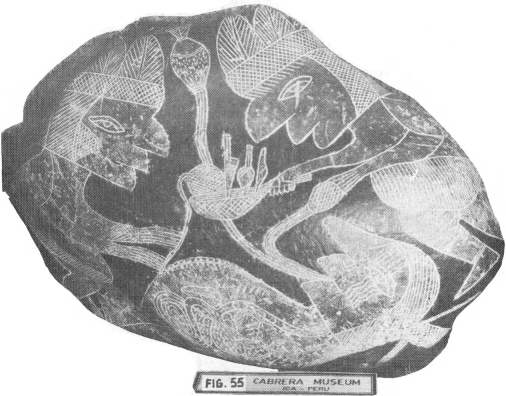
FIGURE 54:
The heart is being transplanted and is being irrigated with the blood of a
pregnant woman.
FIGURE 55: The heart has been transplanted and one of the surgeons sutures the
wound with an instrument powered by electronic energy that cones from the
apparati that can be seen in the upper part of the picture. This apparati has
two branches: one for the suture and the other as a ground wire. The apparatus
that the surgeon has in his hand that is connected with the mouth of the patient
represents symbolically the oral administration of the anti-rejection hormone.
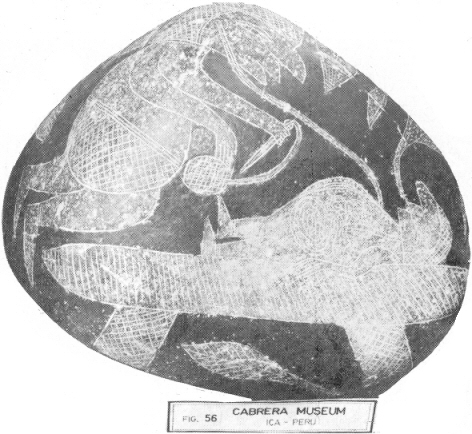
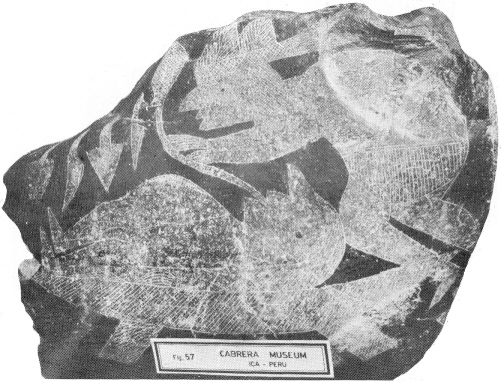
FIGURE 56:
The surgeon has confirmed that the heart that has just' been transplanted is
functioning, using an instrument that symbolically suggests a stethoscope. The
leaf - symbol of life - that appears under the operating table also confirms
this. The figure connected to the mouth of the patient indicates that he is
receiving a nutrient. The absence of a triangle full of rhomb-like figures that
appeared under the patientís neck, reveals that the patient does not need the
complex system of electronic apparati that stimulate and control the biological
functions to keep it alive.
FIGURE 57: The surgical operation has finished. This is manifest in the fact
that in this scene, different from all the others in the series, the internal
organs of the patient have not been shown. The heart transplant has thus been a
success. The symbol of the anti-rejection hormone connected to the mouth of the
patient probably expresses the need to keep administering it orally in the
post-operation phase. The biological functions of the individual will continue
to be stimulated and controlled for a time, as is revealed by the triangle full
of rhomb-like figures under his neck.
THE MENSTRUAL CYCLE OF A WOMAN
SYMBOLIZED ON A TUMI
In different parts of the world,
trepanated cranea of ancient man have been found, that have led us to suppose
that these men fed themselves on brains or that perhaps the trepanation was
performed for ritual or shamanistic reasons or to cure various mental illnesses.
But, since in the graves of ancient Peru, in addition to trepanated cranea,
metal cutting instruments such as the tumi, scalpels, chisels, separators and
pincers have been found, (made of the metal called champi: an alloy of gold,
silver and copper), this would lead us to suspect that the Incas and the
Pre-Incan civilizations had advanced knowledge of surgical techniques, anatomy
and neurophysiology, that allowed them to trepanate the cranium to intervene in
the brain.
When I spoke of other materials used by
the gliptolithic humanity to leave messages I mentioned gold. I mentioned that
this metal was used initially in the form of tablets, and afterwards in the form
of different objects, and that one of these was the tumis of gold with inlays of
precious stones. I also mentioned that these tumis, made of the hard metal
called champi, were made by the gliptolithic humanity, and I would like to add
that all the instruments made of this metal, (scalpels, chisels, separators,
pincers, etc.), belonged to this humanity.
Through excavations performed in Inca
and Pre-Inca tombs - and especially in the tombs of the Paracas culture - cranea
with holes have been found, and some have been found with gold and silver plates
covering the holes or with fragments of squash gourds. Many of the cranea reveal
that the process of bone healing has taken place and that the individual has
survived the trepanation.
Contemporary surgery trepanates the
cranium with the purpose of diagnosing and treating illnesses in the bones of
the cranium or of the organs contained in the cranial cavity. To obtain these
objectives there is an extremely advanced body of knowledge dealing with the
structure and functions of the brain, of the membranes that cover it, of the
liquid contained in the cranial cavity and of the bones that make up the
cranium. There are also advanced surgical techniques that are facilitated by the
use of specialized instruments, among which the electric saw to perform the
trepanation and mechanical and electric instruments to manipulate organs and cut
and suture blood vessels are indispensable. To this must be added the use of
anesthetics that are scarcely toxic and that permit an extension of the length
of the operation so necessary for operations of the brain.
The Inca and Pre-Inca cultures were
very far from obtaining even mediocre scientific and technological process in
general, and even less in this specialized field of neurosurgery. Consequently,
the trepanations that occurred, if they had some surgical significance, were
never more than simply operations of the bone, possibly to repair damage done to
the cranial cavity. To affirm that these openings in the cranea were made to
provide access to the brain tissues would thus be absurd. It is well known that
contemporary humanity, (of which these civilizations were a part more than three
thousand years ago), has only in this century acquired the necessary knowledge
to investigate the brain tissue scientifically. It is most probable that the
trepanations trade by Inca and Pre-Inca civilizations were performed to cure
bone fractures that resulted from warfare or accident, or for shamanistic
purposes to cure unknown ailments (migraine headaches, mental diseases, etc.),
based in the curious idea that the cause of these illnesses was the lodging of
evil spirits within the cranial cavity.
The tumis made of gold and champi,
inlayed with precious stones, were made by the gliptolithic humanity with the
purpose of leaving surgical information on them. They do not contain scenes of
surgical operations.
On the gold turns with inlayed precious
stones, the upper part - consisting in some cases of a human figure and in
others of simply a head, but in both cases with ornaments and filigree -
contains the information inscribed in figures and symbols. The lower part has
the shape of a cutting instrument. As this cutting instrument appears as a
symbol of one of the surgical instruments used in the surgical scenes found on
the gliptoliths (Fig. 44), in the tumi it reappears in order to indicate that
the information on this instrument is of a surgical nature. The tumi is not,
then, one of the surgical instruments that the gliptolithic humanity used, it
would not be a very good instrument to use because of the ornaments and
filigree. The obsidian tumis were made by the Inca and Pre-Inca civilizations,
but simply as replicas of the gold and champi tumis of the gliptolithic
humanity, which they must have found by having access to the deposits of
gliptolithic materials. The obsidian tumis do not, however, have the ornaments
or the human figures; they are made simply as replicas of the cutting
instrument, protected on the upper part by a wooden handle tied to it with
chord. This makes me think that the tumis made by the Inca and Pre-Inca
civilizations were cutting instruments, unlike the tumis that the gliptolithic
civilization made. It is possible that these are the instruments with which the
simply trepanations to which I have referred were performed. The tumis of the
gliptolithic humanity must have ended as much of the testimony left by the
gliptolithic culture has: the Inca and Pre-Inca civilizations could not imagine
what these instruments contained scientific information. But, since the tumis
signified the presence of earlier being that these civilizations could not see,
they thought these beings were gods. This is why I am inclined to think that the
aforementioned trepanations must have been, in some cases, ceremonial practices
to honor those gods, and in others methods to cure illness through the divine
intervention that the turn symbolized.
That the golden tumis with precious
stone inlays contain information symbolically inscribed on them is something
that modern archaeology has never suspected. This is because the different
pieces that exist are spread out in the hands of collectors and museums all over
the world. They are collected mainly as artistic objects. Just like the
gliptoliths, these tumis form series. Unfortunately, the ignorance as to what
they signify and the fact that they are so dispersed limits access to these
series, which when studied together could facilitate their interpretation and
allow us to benefit from the knowledge they possess.
By the study that I have made of one
golden tumi with precious stone inlays, I have been able to obtain the
information left by the gliptolithic culture on it regarding the menstrual cycle
of the woman. So that the description and interpretation of the symbols and
figures may be more easily understood, I will briefly refer to the menstrual
cycle of the woman.
During a certain period, in one of the
ovaries of a woman, an ovum natures. Initially, the ovi are ready to begin their
process of maturation. Each one is housed inside a protective cover known as the
Graaf follicle. Inside the follicle the ovum is surrounded by a liquid which is
known as the follicular liquid. But it is only one ovum which will nature during
the fourteen days. The maturation of the ovum is activated by folliculine, a
hormone that is secreted during this time period by the cells of the Graaf
follicle. The mature ovum separates from its follicle and is picked up by the
Eustachian tube. At this point, and for approximately six days, if the ovum
finds the spermatozoid, it will be fertilized. The follicle that once protected
the ovum will be transformed into what is known as the yellow substance and will
produce progesterone, a hormone that encourages the growth of the uterine
membrane so that it may receive the fertilized ovum and proceed with the
gestation. But, if the mature ovum does not encounter a spermatozoid, then
several days afterwards it will destroy itself. The destroyed ovum will then be
eliminated with the uterine membrane; the elimination of the uterine membrane
occurs twenty-eight days after the process of maturation of the ovum has begun.
The elimination of the uterine membrane causes the menstrual hemorrhage. After
this period of twenty-eight days a new process of maturation of a new ovum
begins. This process, that occurs periodically in the ovary, to cause the
maturation of an ovum so that it may be fertilized or eliminated, is known as
the menstrual cycle of the woman. The menstrual hemorrhage occurs normally at
the end of the twenty-eight days of the process and normally lasts five days.
The fertilization of the ovum may occur from the middle of the cycle to six days
afterwards. However, if the spermatozoid was deposited no more than two days
before the middle of the cycle, it can remain alive until the moment that the
nature ovum separates from the follicle and can fertilize it.
The tumi to which I am referring
describes with figures and symbols the menstrual cycle of the woman. On the
forehead of the human figure there is a semicircular helmet that is nothing more
than the representation of a microscopic view of the tissue of the ovary (5 in
Fig. 58). The eight small circles that appear on it represent eight Graaf
follicles, just as they appear in the microscope (6 in Fig. 58). The point that
can be seen in each one of these is an ovum that is about to begin the process
of maturation (remember that only one of the ovi is going to mature), and the
zone surrounding it is the follicular liquid. The ring of tiny balls that
surround the ovum is the set of cells that lines the walls of the follicle,
that, as is known, secrete folliculine during the first fourteen days of the
cycle to activate the maturation of the ovum. Surrounding the upper part of the
helmet there is a zig≠zagging filament (4 in Fig. 58). If the vertices of the
filament are observed, those facing upwards as well as those facing downward, we
will see that the filament forms pyramids, fourteen with their vertices pointing
upwards and fourteen pointing downward. Since in gliptolithic symbology the
pyramid is a captor, accumulator and distributor of energy, we can conclude that
the twenty-eight pyramids symbolically express the different levels of energy
that the ovary during the menstrual cycle that is twenty-eight days long.
Furthermore, the fact that fourteen pyramids have been presented pointing
upwards and fourteen downward, can only indicate that at the end of the first
fourteen days of the menstrual cycle the ovum has finished its process of
maturation and is ready to be fertilized by the spermatozoid, and that if it is
not fertilized, another fourteen days will pass before the process of maturation
will begin anew. Above the filament of pyramids there is a ring of ten circular
filaments, whose centers are arranged inward in pairs as if they were looking at
each other (2 in Fig. 38). Each one of these filaments with curved ends is the
schematic representation of the shape which the fetus adopts in the uterine
cavity. Since they are ten in number, it indicates that if the ovum was
fertilized the period of gestation would last for ten months of twenty-eight
days each (36). Above the whole helmet a border made up of thirty-three little
balls (1 in Fig. 58). This indicates that after the menstrual cycle of
twenty-eight days there will be a period of five days maximum of flow of blood
which, as is known, is normal. Finally another symbol inserted on both sides of
the face can be seen. This is the expanded figure of the ovum in its Graaf
follicle, ready to begin the process of maturation. Their size, in relation to
the ovi that appear in the upper part of the tumi, and the fact that there are
two of them, allows me to deduce that the ovaries of this woman are capable of
producing ovi, that is, they are functioning normally (this capacity does not
mean that both, ovaries produce ovi for the same menstrual cycle; it is well
known that only one does it, whichever of the two). As concerns the rectangular
precious stones that can be seen on the forehead, the neck and the trunk of the
woman, I think they are extragliptolithic elements, added by the Inca or
Pre-Inca civilizations as a consequence of the fact that they could not
understand the tumis of their predecessorsí remote gliptolithic humanity.
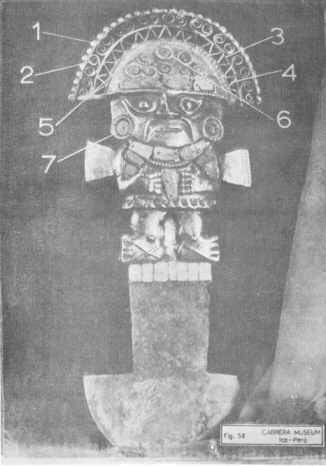
FIGURE 58: A golden tumi with
inlayed precious stones. Like those made of champi (a very hard alloy of gold,
silver and copper), the
golden tumis were made by the gliptolithic humanity with the purpose of
transmitting surgical information. The figures and symbols of this
tumi bear information about the menstrual cycle of the woman. This tumi is part
of a series dealing with surgical pathologies of the ovaries.
They have been found in the Precolumbian tombs of Peru, but they do not belong
to the men of these cultures, belong to the gliptolithic humanity.
The menstrual cycle of the woman is a
normal process that can nevertheless be disturbed through the advent of benign
or malign tumors in the ovaries. In these cases, therapy requires surgery. The
turn whose symbols inform us about the menstrual cycle of the woman is part of a
series of tumis dealing with the surgical pathologies of the ovaries as a
consequence of the presence of tumors. My studies of this series will be
released in another publication.
-----------------------
Footnotes:
(36) In accordance to the gliptolithic
humanity calendar, the year was divided in 13 tenths of 28 days each, making a
total of 364 days. This information is found represented in a gliptolith. Its
reading and interpretation is being explained in Chapter VIII.


